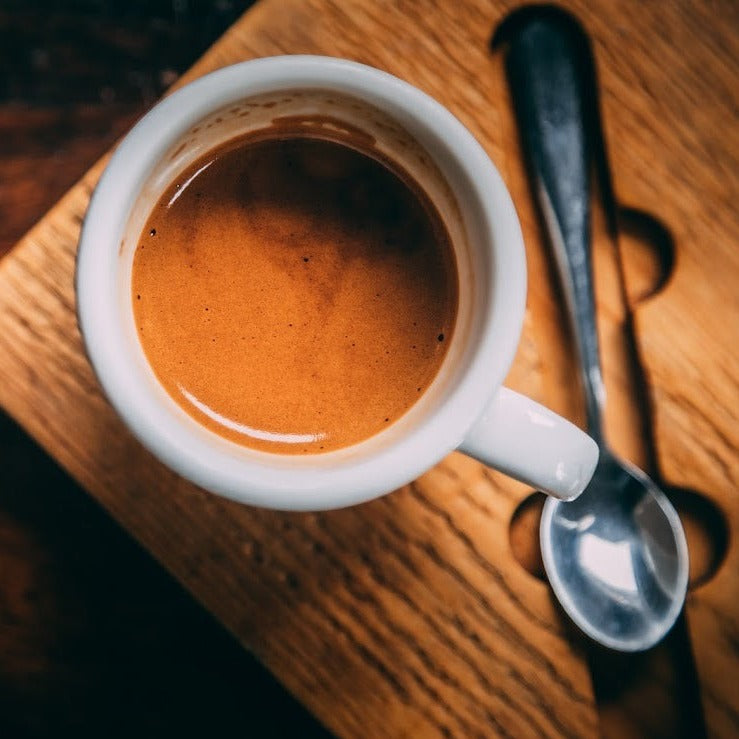Why SOE Single Origin Espresso Is Loved Among Baristas
Why SOE Single Origin Espresso Is Loved Among Baristas
Blog Article
Discovering the Rich Flavors of Coffee Beans: a Deep Study Espresso and Blended Coffee Beans
When you check out the abundant flavors of coffee beans, you uncover a complicated globe where each selection brings its very own personality to your cup. Recognizing the origins, processing approaches, and roasting techniques can transform your coffee experience. As you browse through the art of espresso and the creativity behind combined coffees, you'll begin to appreciate the subtleties that make each sip one-of-a-kind. What you'll discover following could change the means you enjoy your early morning mixture.
The Beginnings of Coffee Beans: Checking Out Terroir and Taste Profiles
When you take a sip of coffee, you're not just appreciating a beverage; you're experiencing an abundant tapestry of tastes formed by the beans' beginnings. Each area produces one-of-a-kind flavor profiles affected by elevation, dirt, and environment. Beans from Ethiopia typically burst with intense, fruity notes, while those from Colombia tend to provide a balanced, nutty sweet taste.
As you explore various beginnings, you'll notice just how terroir-- the ecological aspects influencing a plant-- plays a crucial duty - Single Origin Espresso. The very same coffee selection can taste drastically various relying on where it's grown
When you consider these variables, you begin to value the complexity behind your cup. Each sip informs a tale of the land and the farmers who supported the beans. So, following time you indulge, assume concerning the trip your coffee took prior to it reached your hands, and relish those complex flavors that reflect its beginning.
Recognizing Espresso: The Art and Scientific Research Behind the Mixture
When you think of coffee, it's not almost the solid flavor; it's likewise concerning the techniques that bring it to life. Comprehending just how different preparation techniques impact preference can transform your brewing experience. Let's explore the complexities of espresso preparation and reveal the one-of-a-kind flavor profiles that make each cup unique.
Coffee Preparation Techniques
Coffee preparation is both an art and a science, integrating accurate methods with a deep understanding of coffee. To start, you'll intend to choose top quality, newly roasted beans and grind them carefully for perfect extraction (Single Origin Espresso). The grind dimension is vital; also rugged, and your espresso will be weak, too fine, and it'll be bitter
Following, tamp the premises uniformly in the portafilter to assure consistent removal. When you secure it right into the device, goal for a brewing temperature level in between 190 ° F and 205 °
F.As you pull the shot, watch for the best extraction time-- around 25-30 seconds. The result should be an abundant, creamy coffee with a gorgeous layer of crema on top. With method, you'll understand these techniques.
Taste Profiles Clarified
The world of espresso uses a rich tapestry of taste profiles that can boost your coffee experience. When you take that very first sip, you'll notice a balance of sweetness, anger, and acidity. Each espresso bean carries distinct notes, from flower and fruity to nutty and chocolaty. Light roasts often showcase brilliant acidity and dynamic flavors, while dark roasts present much deeper, bolder tones.
Understanding these accounts aids you choose the appropriate coffee for your taste buds. Explore different blends can expose unexpected mixes. For circumstances, a well-crafted mix may harmonize the bright notes of an Ethiopian bean with the rich, chocolatey undertones of a Brazilian bean. Embrace the journey of discovering espresso's diverse flavors, and you'll change your coffee ritual right into an interesting experience.
Processing Techniques: Just How They Impact Taste and Scent
While it may appear that the origin of coffee beans is one of the most significant consider establishing their taste and scent, the handling approaches made use of post-harvest play a similarly important role. You'll locate that these methods can significantly alter the last preference account of your cup.
As an example, the washed procedure removes the fruit from the beans before fermentation, often causing a cleaner, brighter taste. The all-natural process leaves the fruit undamaged during drying out, resulting in a sweeter, fruitier profile.
Other methods, like honey handling, strike an equilibrium, permitting some fruit mucilage to continue to be, providing a special intricacy.
Each processing method engages with the beans' fundamental features, boosting or muting specific tastes and scents. So, when you sip that coffee or mixed coffee, keep in mind that the trip from cherry to cup is affected not just by origin however likewise by just how those beans were processed.
Toasting Strategies: Opening the Complete Potential of Coffee Beans
Roasting techniques are vital for revealing the complete possibility of coffee beans, as they change raw, eco-friendly beans right into the fragrant, tasty coffee you Get More Information enjoy. The option of roasting technique-- light, medium, or dark-- significantly affects taste profiles. Light roasts maintain the beans' all-natural level of acidity and fruity notes, while medium roasts balance sweetness and splendor. Dark roasts, on the various other hand, stress strong, great smoky flavors.
A slower roast at reduced temperature levels enables for complex tastes to establish, while a quicker roast can heighten resentment. By understanding these methods, you'll disclose a globe of taste, boosting your coffee experience to new elevations.
The Magic of Blended Coffee: Producing Unique Taste Experiences
Developing a special flavor experience with mixed coffee can change your early morning routine right into an exploration of taste. By integrating different beans from numerous areas, you can disclose a harmony of tastes that elevate your mug to new heights. Each mix deals a distinct profile, balancing body, acidity, and sweet taste to create something truly special.
When you choose a blend, you're not just picking a coffee; you're choosing a journey across diverse landscapes and societies. Trying out various mixes permits you to uncover your personal faves, whether you appreciate fruity notes or abundant, chocolatey touches.

Tasting Notes: Acknowledging the Subtleties in Your Mug
As you sip your coffee, you may notice a spectrum of tastes dancing on your taste, each revealing the intricacies of the beans. You might taste the bright level of acidity reminiscent of citrus or the deep, rich notes akin to dark chocolate. The sweetness could stimulate honey or caramel, balancing the overall account magnificently.
Pay focus to the body of the coffee-- does it feel light and ventilated, or is it full and creamy? The coating, as well, provides hints; a lingering aftertaste might mean nuttiness or flower undertones.

Do not forget to discover the one-of-a-kind attributes of different origins, as each area gives distinct flavors - Single Origin Espresso. For instance, Ethiopian coffees typically present fruity notes, while Colombian beans might showcase an extra rounded sweetness. By acknowledging these subtleties, you'll grow your gratitude for each and every mug, raising your coffee experience to new heights

Developing Methods: Making Best Use Of Taste Removal for Every Bean
When you check out the various brewing techniques, you'll discover that each method can dramatically affect the taste account of your coffee. From French press to pour-over, each approach removes different substances, boosting or silencing specific notes. Making use of a French press enables oils to remain in the mixture, creating a richer preference, while pour-over emphasizes quality and brightness.
Temperature level and grind size likewise play vital duties. A coarser grind functions best for cold mixtures, while a fine grind about his is ideal for espresso. Trying out water temperature-- in between 195 ° F and 205 ° F-- can reveal surprise flavors, as well.
Do not forget steeping time; a fast removal can result in sour notes, while over-extraction might yield resentment. By adjusting these variables, you can make the most of taste removal and really boost your coffee experience. Delight in the trip of discovering what technique ideal suits your taste!
Regularly Asked Questions
What Is the Suitable Water Temperature Level for Brewing Coffee?
The suitable water temperature for developing coffee's in between 195 ° F and 205 ° F. If you use water important source that's as well warm, you'll over-extract flavors; too chilly, and you will not extract enough. Go for that sweet area for the ideal mixture!
Exactly How Does Grind Dimension Affect Coffee Flavor?
Grind dimension considerably influences coffee flavor. Better grinds remove much more tastes and oils, leading to a bolder preference, while coarser grinds yield a lighter flavor. Readjusting grind size aids you achieve your desired coffee profile.
Exist Health And Wellness Perks Linked With Alcohol Consumption Coffee?

What Is the Difference Between Arabica and Robusta Beans?
Arabica beans are smoother and sweeter, frequently featuring fruity flavors, while robusta beans are stronger with a bitter preference and greater high levels of caffeine material. You'll observe these distinctions in scent and brewing experience.
How Can I Store Coffee Beans for Quality?
To save coffee beans for quality, maintain them in an impermeable container, far from dampness, warmth, and light. If you only grind what you need right before brewing., you'll preserve their taste longer.
Checking Out the Rich Tastes of Coffee Beans: a Deep Dive Into Coffee and Blended Coffee Beans.
When you explore the abundant flavors of coffee beans, you uncover an intricate world where each selection brings its very own character to your cup.When you take a sip of coffee, you're not simply appreciating a drink; you're experiencing an abundant tapestry of flavors formed by the beans' origins.Roasting techniques are crucial for exposing the full capacity of coffee beans, as they transform raw, environment-friendly beans into the fragrant, tasty coffee you appreciate.As you sip your coffee, you could observe a range of flavors dancing on your taste, each revealing the details of the beans.
Report this page